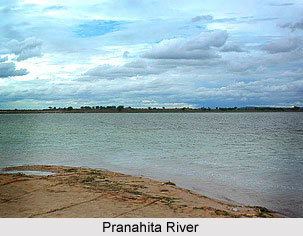- left Dina River - location Kaleshwaram, Telangana Basin area 109,078 km² Mouth Godavari River Country India | - elevation 146 m (479 ft) - elevation 107 m (351 ft) Length 113 km Source Wainganga River | |
 | ||
- right Nagulvagu River, Peddawagu River - location Koutala, Maharashtra, India | ||
Pranhita river
Pranhita is the largest tributary of Godavari River covering about 34% of its drainage basin conveying the combined waters of the Penganga River, Wardha River and Wainganga River.By virtue of its extensive network of tributaries, the river drains all of Vidharba region as well as the southern slopes of the Satpura Ranges. It flows along the border of Gadchiroli district in Maharashtra and Adilabad district in Telangana. The Pranhita sub-basin is the 7th largest in India, measuring about 1,09,078 km2 making it larger than the individual basins of significant rivers like the Narmada and Cauvery.
Contents
Map of Pranhita River
Origin
The Pranhita begins at the confluence of 2 extensive rivers - the Wardha (catchment area: 46,237 km2) and the Wainganga (catchment area:49,677 km2).This junction lies on the border between the states of Maharashtra and Telangana near Kouthala(near Sirpur kagaznagar). Right at the onset, the river enjoys a wide river bed.
Course
The river follows a short course of 113 km strictly adhering to the boundary between Gadchiroli district in Maharashtra and Adilabad district in Telangana.The direction of flow is southward unlike most rivers of the Deccan Plateau. Along its course the river is flanked by thick forests and harbors a rich biodiversity of flora and fauna. After completing its short journey the river empties itself into the Godavari River at Kaleswaram.
Dams
The river does not have any dams built on it so far.But a water project to construct a barrage is currently underway.This project envisioned at an estimated cost of Rs.38,500 crore is known as the Pranahita Chevella lift irrigation scheme and a joint project between the Maharashtra and Telangana.
Uses
The River is used for water transport between Sironcha(MH) and Kaleswaram(TS).
It is also a part of the 12 rivers in the Pushkaram list which is a festival in Hindu traditions.
